Enhanced TDS
Knowde-enriched technical product data sheet
Identification & Functionality
- Chemical Family
- Plastics & Elastomers Functions
- Technologies
- Product Families
Features & Benefits
- Materials Features
- Features
PELESTAT 300 has the following features:
- This product imparts excellent antistatic and antifouling properties to polyolefin when the amount added is between 5 and 15 wt %.
- This product exhibits a permanent antistatic property immediately after molding. The antistatic property in the resulting plastic minimally changes even after washing with water because it is a high-molecular-weight antistatic agent. In addition, it works even in low humidity due to its low dependency on humidity.
- This product dry-blended with polyolefin can be directly molded into the final product without a kneading process. Moreover, this product minimally affects the mechanical properties and moldability of the polyolefin.
Applications & Uses
- Markets
- Applications
- Compatible Polymers & Resins
- Plastics & Elastomers End Uses
- Plastics & Elastomers Processing Methods
- Application Methods
1. General Procedure
As shown in Figure 1, polyolefin and PELESTAT 300 are dry-blended using a blender.
This blend is then molded into the final product using an appropriate molder (e.g., injection
molding machine). Fillers and dispersants can be added during the dry-blending process if necessary.
a) normal flow process
b) if kneading is required.Figure 1. General Procedure for Application of PELESTAT 300
2. Amount to be Used
The standard amount of PELESTAT 300 is between 5 and 15 wt %.
Determine the optimal amount by referring to the results of its performance tests.3. Kneading Conditions
Use a high share rate kneader (e.g., a twin-screw extruder) if the kneading process is required. The standard kneading temperature is between 180 and 230 °C (356 – 446 °F). Determine the kneading temperature according to the resin applied.4. Drying of PELESTAT 300
- This product can be immediately used after the factory sealed package is opened because this product is packed under moisture-proof conditions.
- Drying is necessary when the factory sealed package is kept unsealed for several hours because this product has some hygroscopic properties. The following are examples of the conditions for drying.
Drying under reduced pressure Vacuum Below 1300 Pa (0.2 psi) Temperature 70°C – 80°C (158°F – 176°F) Duration 2 – 4 hours Hot-air drying Duration 4 – 6 hours Temperature 85°C – 95°C (185°F – 203°F) 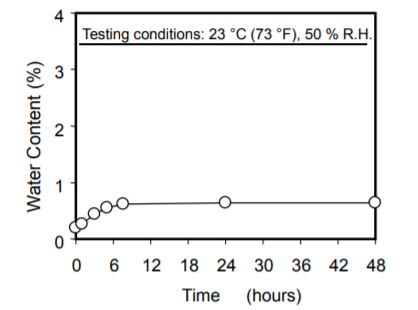
Figure 2. Hygroscopic Properties of PELESTAT 300
Precaution Against Mishandling
- In the case of using resins at molding temperatures below 160 °C (320 °F), PELESTAT 300 may not fuse, possibly resulting in poor effectiveness. Furthermore, in case of using resins at molding temperatures above 240 °C (464 °F), this product may thermally decompose, possibly resulting in poor effectiveness. The recommended molding temperature is between 160 and 230 °C (320 – 446 °F).
- Depending on the kind of resin, this product may have an influence on the resin's physical properties including mechanical properties. Test their influence on each other’s physical properties beforehand to ensure that there are no problems.
- Examples of Applications
PELESTAT 300 has been used as a permanent antistatic agent in polyolefin in the following
applications:- Various containers and storage cases for electric and electronic parts, etc.
- Household electrical goods, office equipment, etc.
- Floor materials, base materials for tapes, etc.
Properties
- Physical Form
- Appearance
- Pale yellow pellet
- Typical Properties
Value Units Test Method / Conditions Melting Point approx. 135 (275) °C(°F) DSC, ASTM D 3418 Melting Point approx. 163 (325) °C(°F) - Surface resistivity approx. 1 × 10^8 Ω ASTM D 257 Thermal Degradation Temperature approx. 240 (464) °C(°F) - Surface Resistivity approx. 5 × 10^7 Ω ASTM D 257 Thermal Degradation Temperature (The lowest temperature at which PELESTAT 300 begins to thermally decompose. (Measured using a thermal gravimeter in air) approx. 250 (482) °C(°F) -
Regulatory & Compliance
- Patent Registered
USP 6,552,131
Technical Details & Test Data
- Performance Tests
The examples on pages 4 to 7 are the results of performance tests using polyolefin mixed with PELESTAT 300. This product imparts a permanent antistatic property to polyolefin that cannot be attained by any other conventional blend-type, low-molecular-weight antistatic agent. Furthermore, this product minimally affects the physical properties of polyolefin because this product is highly compatible with it.
1. Application to PP
A. Relationship Between Amount of PELESTAT 300 and Resulting Surface Resistivity
PP containing PELESTAT 300 is highly antistatic when the concentration of this product is between 5 and 15 wt %. Refer to Figure 3 and determine the optimal amount according to the desired surface resistivity.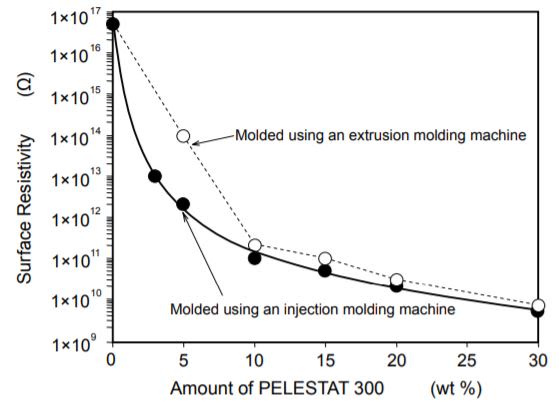
Amount of PELESTAT 300 (wt %)
Figure 3. Relationship Between Amount of PELESTAT 300 and Surface Resistivity
Materials and Methods:
Materials:Injection molding machine
A predetermined amount of PELESTAT 300 was dry-blended with PP and the mixture was molded using an injection molding machine [nozzle temperature: approx. 220 °C (428 °F), mold temperature: approx. 50 °C (122 °F)] into samples 2 mm (approx. 0.08 inches) in thickness.Extrusion molding machine
A predetermined amount of PELESTAT 300 was dry-blended with PP and the mixture was molded using an extrusion molding machine [die temperature: approx. 220 °C (428 °F)] into sample 100 μm (approx. 3.9 mils) in thickness.Method:
Each sample was kept at 23°C(73°F), 50 % R.H. for 24 hours. Then, the surface resistivity of each was measured using a megohmmeter according to ASTM D 257.B. Effect on Surface Resistivity When Washed with Water (Evaluation of Durability of Antistatic Effect) The surface resistivity of the LDPE blended with PELESTAT 230 minimally changes, remaining antistatic even when washed with water. This product imparts a permanent antistatic property that cannot be attained by any other conventional blend-type, low-molecular-weight antistatic agent, which loses its antistatic property after being washed with water approximately three times.
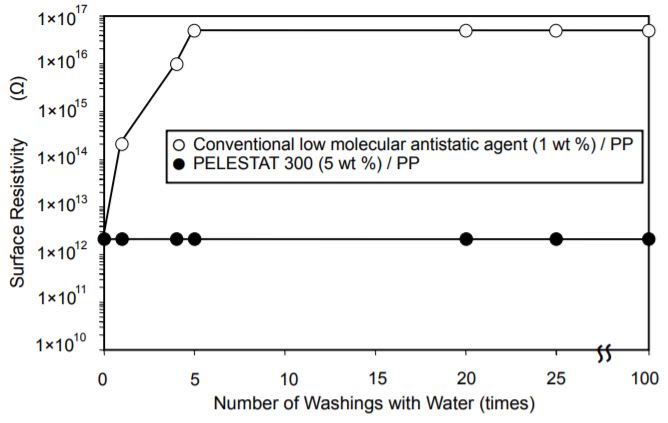
Number of Washings with Water (times)
Figure 4.Effect on Surface Resistivity When Washed with Water
Materials and Methods:
Materials:- PELESTAT 300 (5 wt %) / PP
- PELESTAT 300 (5 wt %) was dry-blended with the PP and the mixture was molded using an injection molding machine [nozzle temperature: approx. 220 °C (428 °F); mold temperature: approx. 50 °C (122 °F)] into samples 2 mm (approx. 0.08 inches) in thickness.
- Conventional low-molecular-weight anionic antistatic agent (1 wt %) / PP
A conventional blend-type, low-molecular-weight antistatic agent, a Sanyo Chemical product, was applied. After it was kneaded using a twin screw extruder at approx. 220 °C (428 °F), the kneaded material was molded into samples by using the method described above.
Method:Each sample was submerged in water and their surfaces were rubbed with a cotton cloth. The samples were dried under reduced pressure [133 Pa (0.02 psi)] at 70 °C (158 °F) for 2 hours and were kept at 23 °C (73 °F), 50 % R.H. for 24 hours. The surface resistivity was measured using a megohmmeter according to ASTM D 257. This process was repeated according to the number of washings with water as described in Figure 4.
C. Effect of Humidity on Surface Resistivity
The surface resistivity of the PP blended with PELESTAT 300 minimally changes even in low humidity due to this product’s low dependency on humidity. Conversely, an LDPE blended with any other conventional low-molecular-weight antistatic agent loses its antistatic property in low humidity.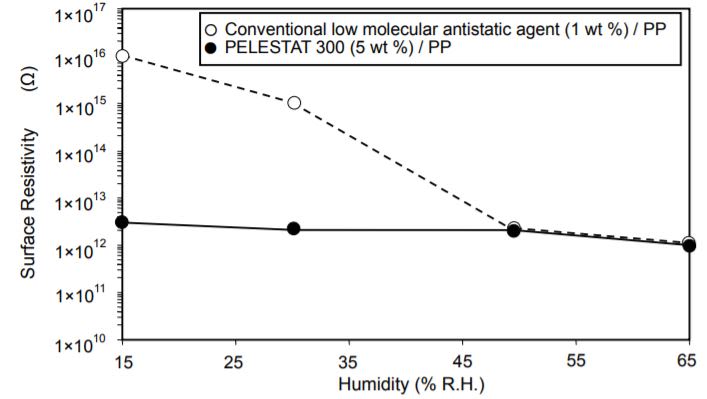
Figure 5. Effect of Humidity on Surface Resistivity
Materials and Methods:
Materials: See Figure 4.
Method:
Each sample was kept at 23°C (73°F) at a predetermined humidity for 24 hours. Then, the surface resistivity of each was measured using a megohmmeter according to ASTM D 257.D. Effect on Resin Physical Properties
As shown in Table 1, PELESTAT 300 minimally affects the PP physical properties.Property Method PELESTAT 300
5 wt %) / PPPP Surface resistivity Ω ASTM D 257 2 × 10^12 > 10^16 Melt flow rate
(10 min, 190°C, 21.18 N) gASTM D 1238 12 10 Tensile strength MPa (psi) ASTM D 638 29 (4200) 28 (4,000) Fracture elongation % ASTM D 638 300 280 Flexural modulus MPa (psi) ASTM D 790 1,200 (174,000) 1,200 (174,000) Izod impact strength (notched) J/m (ft.Ibf/in) D 256 80 (1.5) 80 (1.5) Impact resistance Du Pont method J (ft.Ibf) (JIS K 5400) 20 (15) 20 (15) Deflection temp. under load
(0.45 MPa) °C (°F )D 648 84 (183) 85 (185) Materials and Methods:
Materials:
Surface resistivity
PELESTAT 300 (5 wt %) was dry-blended with the PP and the mixture was molded Under same conditions as described in Figure 4 into samples 2 mm (approx. 0.08 inches) in thickness.Melt flow rate
The above molded materials were cut into pellets, and used as samples.
Other mechanical properties
Samples were prepared under the same conditions described in Figure 4 except that the
predetermined size described in ASTM was applied.
PP was also molded under the same conditions.
Methods:
See the methods described in Table 1.
(The testing method for surface resistivity is described in Figure 3.)E. Dispersibility of PELESTAT 300 in PP
As shown in Figure 6, PELESTAT 300 is finely dispersed in the PP.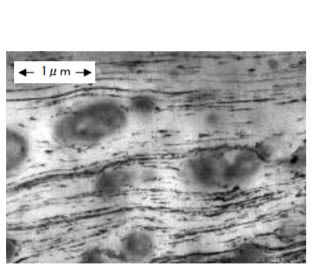
Figure 6. Transmission Electron Micrograph of Molding (TEM photo)
Composed of PELESTAT 300 (5 wt %) and PP[Explanation of Photograph]
Black stripes: PELESTAT 300
Black particles: Ethylene-propylene rubber component of PP
Figure 6 is a magnification (approx. 15,000 times) of a section of the PELESTAT 300
5 wt %) / PP mixture described in Figure 4. This product (black stripes) is dispersed
in PP (white portion) and works as a conductive network.2. Application to Linear Low Density Polyethylene LLDPE
PELESTAT 300 imparts an excellent antistatic property to the LLDPE.
This product is highly dispersive in LLDPE and minimally affects its physical properties.Table 2. Effect of LLDPE Physical Properties
Property Method
ASTM No.PELESTAT 300
(5 wt %) / LLDPEPP Surface resistivity Ω D257 5 × 10^12 > 10^16 Melt flow rate
(10 min, 190 °C, 21.18 N ) gD 1238 11 10 Tensile strength MPa (psi) D638 8 (1,200) 8 (1,200) Fracture elongation % D638 230 240 Materials and Methods:
Materials:
Surface resistivity
PELESTAT 300 (5 wt %) was dry-blended with the LLDPE and the mixture was molded using an injection molding machine [nozzle temperature: approx. 200 °C (392 °F); mold temperature: approx. 50 °C (122 °F)] into samples 2 mm (approx. 0.08 inches) in thickness.
Melt flow rate
The above molded materials were cut into pellets, and used as samples.
Other mechanical properties Samples were prepared under the same conditions described in Figure 4 except that the predetermined size described in ASTM was applied.
LLDPE was also molded under the same conditions.Methods:
See ASTM No. described in Table 2.
(The testing method for surface resistivity is described in Figure 3.)
Safety & Health
- Hazards Description
PELESTAT 300 is a polyether-polyolefin block copolymer.
This product is insoluble in water. This product has no flash point (by COC) below 230 °C (446 °F). UN dangerous goods regulations are not applied to this product.
Vapor or fume from molten material causes eye and nose irritation. This product has low acute oral toxicity and has no acute dermal irritation. Acute oral toxicity (rat): LD50> 2,000 mg/kg (similar product) Acute dermal irritation (rabbit): Non-irritant (similar product) This product is for industrial use only.